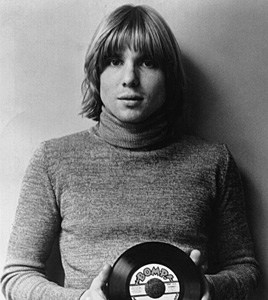
No statue? This will have to do.
“I’m often asked what makes Bomp different. One answer is that where most labels concentrate on a small roster, I’ve always preferred to give a lot of bands the chance to be heard…I guess I’d most like Bomp to be remembered as a label utterly dedicated to the people who care most about music: the fans and collectors.”
Five years ago we lost one of our greatest soldiers, Greg Shaw. Most pop music writers have read him if not been influenced by him; many saw an opportunity to take the leap from fan to participant because of his magazine and his labels. Shaw began by writing fan letters to magazines and was soon writing reviews for everyone from Rolling Stone to Creem. Along the way his journey led to managing bands, working at major labels (assembling compilations, of course) and running a record shop, but legions of powerpop fans point to a 1978 issue of Bomp Magazine as the rallying cry that launched a movement.
“Punk had already had its day by 1978, when Bomp Magazine ran a cover story proposing Powerpop: a hybrid style with the power and guts of punk, but drawing on a pop song tradition with wider popular appeal. I had in mind bands like The Who and The Easybeats, (hell, even The Sex Pistols fit my definition!) but much to my chagrin, the term was snapped up by legions of limp, second-rate bands hoping the majors would see them as a safe alternative to punk. I took a lot of heat for starting the whole business…”

But he should also get credit for what did go right. Many great bands rose from the masses of skinny tie wannabes, and some (including Shoes, 20/20, Paul Collins, The Plimsouls, and The Romantics) started at Bomp before landing at major labels. Writers including Lester Bangs, Greil Marcus, Dave Marsh, Mike Saunders and R. Meltzer passed through his masthead. That Bomp didn’t become a haven for great bands like Sire Records is a shame, but Shaw was unwilling to compromise his vision just to play on a bigger stage.
In the ’80s retro-garage was bursting out thanks to bands like The Fuzztones, The Lyres and The Chesterfield Kings; Shaw’s Voxx label attracted a ton of groups. He launched a series of compilations called Pebbles (inspired by Nuggets) featuring some of the rarest original ’60s punk records from his personal collection. He picked up Iggy Pop’s first solo album, Kill City (“when nobody else would touch it”) and issued a series of Stooges outtakes under the title of The Iguana Chronicles. In the ’90s he aligned with Alive Naturalsound Records which brought great bands like Black Keys, Bloody Hollies and Soledad Brothers into the fold, and he continued to discover and nurture new bands that tweaked his antennae until his death from heart failure. He was only 55.
I think the essence of Greg Shaw can be found in this quote:
“I think it comes down to the fact that Bomp is an outgrowth of my love for music. Where many would view it as a marginal business that barely breaks even, I prefer to see it as a hobby that’s profitable enough to allow me to build my life around it.”
Contemplating the impact Greg Shaw had upon the industry, it just makes me sadder when I think about politics and greed making charlatans wealthy and famous, while true visionaries are sometimes just cult heroes. But fame is cheap commodity and wealth dissipates. Legacy is the coin that matters, and Shaw’s legacy continues to inspire.
The BOMP website
Tributes from other writers
The book: Saving The World One Record at a Time
The date of October 19th also claimed guitarist Glen Buxton of the original Alice Cooper Band, who died in 1997; he was only 49.








